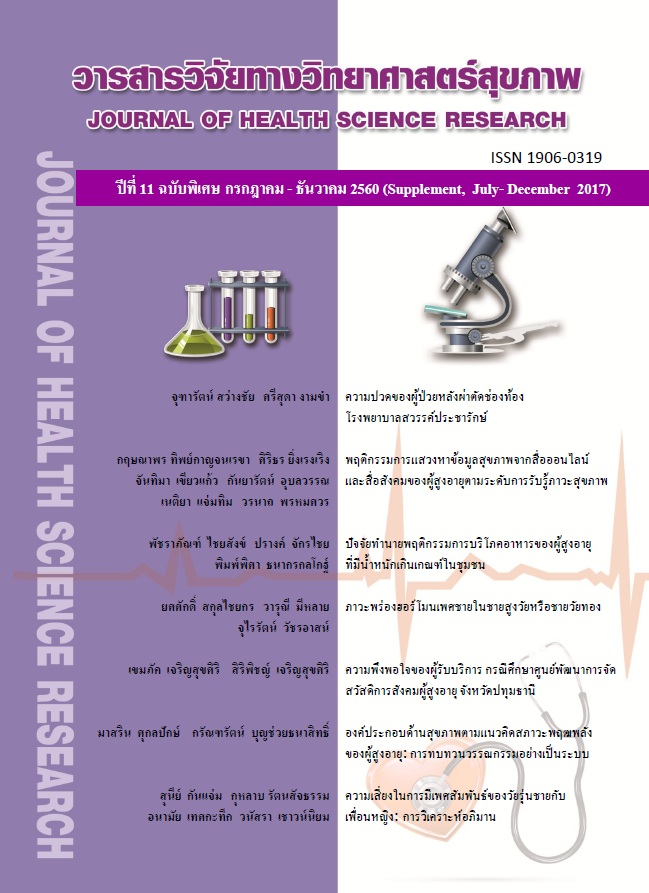ความปวดของผู้ป่วยหลังผ่าตัดช่องท้องโรงพยาบาลสวรรค์ประชารักษ์
Main Article Content
บทคัดย่อ
บทคัดย่อ
การผ่าตัดช่องท้องเป็นการผ่าตัดใหญ่ก่อให้เกิดความปวดแก่ผู้ป่วยทั้งทางร่างกายและจิตใจ งานวิจัยนี้มีวัตถุประสงค์เพื่อศึกษาระดับความปวด ตำแหน่งที่ปวด ปัจจัยที่ส่งเสริมและยับยั้งความปวด วิธีการจัดการกับความปวด รวมทั้งศึกษาความสัมพันธ์ของปัจจัยที่เกี่ยวข้องกับระดับความปวดหลังผ่าตัดช่องท้องใน 24 ชั่วโมงแรกหลังผ่าตัด กลุ่มตัวอย่าง คือ ผู้ป่วยหลังผ่าตัดช่องท้องจำนวน 200 รายที่หอผู้ป่วยศัลยกรรมชาย โรงพยาบาลสวรรค์ประชารักษ์โดยใช้แบบสอบถามความปวดที่ดัดแปลงมาจากของแมคกิลล์ฉบับภาษาไทย (Thai Short–Form McGill pain Questionnaire) และ Long Form McGill Pain Questionnaire วิเคราะห์ข้อมูลโดยใช้สถิติร้อยละ ค่าเฉลี่ย ส่วนเบี่ยงเบนมาตรฐาน และ Chi-square test
ผลการวิจัยพบว่าในระยะ 24 ชั่วโมงแรกหลังการผ่าตัดช่องท้อง ผู้ป่วยส่วนใหญ่มีความปวดอยู่ในระดับปานกลาง (ร้อยละ 56.00) ตำแหน่งของความปวดที่ตรงกลางหน้าท้อง (ร้อยละ 46.50) ลักษณะของความปวดเป็นแบบปวดจี๊ด (ร้อยละ 10.50) สิ่งที่ทำให้ความปวดเพิ่มขึ้นคือ เวลาขยับตัว (ร้อยละ 78.00) สิ่งที่ทำให้ความปวดลดลง คือ การนอนพัก (ร้อยละ 57.00) วิธีการจัดการความปวดที่เลือกใช้คือ การไม่ใช้ยา (ร้อยละ 47.50) รองลงมาคือการใช้ยาแก้ปวด (ร้อยละ 29.50) การตั้งเป้าหมายไว้ว่าความปวดควรอยู่ในระดับใดมีความสัมพันธ์กับระดับความปวดหลังผ่าตัดอย่างมีนัยสำคัญทางสถิติ (p=.003) แต่ปัจจัยด้านอายุ ชนิดของการผ่าตัด และระยะเวลาในการผ่าตัดไม่มีความสัมพันธ์กับระดับความปวดหลังผ่าตัด เพื่อการพยาบาลที่มีประสิทธิภาพ พยาบาลควรส่งเสริมให้ผู้ป่วยตั้งเป้าหมายระดับความปวดที่อยู่บนกรอบความจริงของสภาพผู้ป่วย และให้การดูแลจัดการความปวดสอดคล้องกับเป้าหมายที่ผู้ป่วยกำหนดไว้
Abstract
Major abdominal surgery causes suffering of patients under both physical and psychological aspects. The descriptive research aimed to explore the pain characteristics of patients with abdominal surgery and examine the relationship between certain perioperative characteristics and pain score 24 hours after surgery. The sample was 200 patients with abdominal surgery in Sawanpracharak hospital. They completed the general information and the McGill pain questionnaire Thai version. The statistics included frequency, mean value, standard deviation, and Chi-square test. The findings revealed that in the first 24 hours pain was moderate (56.00%), mid line located (46.50%) and of shooting quality (10.50%). Movement increased pain (78.00%) whereas sleeping decreasing it (57.00%). Thirty one percent of the patients required pain management. Setting a pain goal before surgery had a significant impact on pain score after surgery (p = .003), whereas other factors, such as age, operation type, and operation period had not. We conclude that setting a pain goal preoperatively has an effect on postoperative pain control in patients with abdominal surgery. In order to manage pain effectively, nurses should let the patients set a pain goal before surgery.
Downloads
Article Details
บทความที่ได้รับการตีพิมพ์เป็นลิขสิทธิ์ของวิทยาลัยพยาบาลบรมราชชนนี จังหวัดนนทบุรี
ข้อความที่ปรากฏในบทความแต่ละเรื่องในวารสารวิชาการเล่มนี้เป็นความคิดเห็นส่วนตัวของผู้เขียนแต่ละท่านไม่เกี่ยวข้องกับวิทยาลัยพยาบาลบรมราชชนนี จังหวัดนนทบุรี และคณาจารย์ท่านอื่น ในวิทยาลัยฯ แต่อย่างใด ความรับผิดชอบองค์ประกอบทั้งหมดของบทความแต่ละเรื่องเป็นของผู้เขียนแต่ละท่าน หากมีความผิดพลาดใด ๆ ผู้เขียนแต่ละท่านจะรับผิดชอบบทความของตนเองแต่ผู้เดียว


